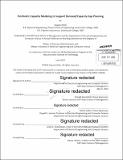| dc.contributor.advisor | Donald Rosenfield and Patrick Jaillet. | en_US |
| dc.contributor.author | Niles, Augusta (Augusta L.) | en_US |
| dc.contributor.other | Leaders for Global Operations Program. | en_US |
| dc.date.accessioned | 2014-10-08T15:28:03Z | |
| dc.date.available | 2014-10-08T15:28:03Z | |
| dc.date.copyright | 2014 | en_US |
| dc.date.issued | 2014 | en_US |
| dc.identifier.uri | http://hdl.handle.net/1721.1/90770 | |
| dc.description | Thesis: M.B.A., Massachusetts Institute of Technology, Sloan School of Management, 2014. In conjunction with the Leaders for Global Operations Program at MIT. | en_US |
| dc.description | Thesis: S.M., Massachusetts Institute of Technology, Department of Electrical Engineering and Computer Science, 2014. In conjunction with the Leaders for Global Operations Program at MIT. | en_US |
| dc.description | 24 | en_US |
| dc.description | Cataloged from PDF version of thesis. | en_US |
| dc.description | Includes bibliographical references (pages 62-63). | en_US |
| dc.description.abstract | Capacity strategy has established methods of dealing with uncertainty in future demand. This project advances the concept of capacity strategy under conditions of uncertainty in cases where capacity is the primary source of uncertainty. Novartis Vaccines, one of five divisions of Novartis AG, produces nearly two dozen vaccines which are offered in syringes, vials, multi or single pack, and multi or single dose and delivered in language-specific packaging to countries all over the world. Bexsero is a new product in 2013. As demand for Bexsero and other products increases over the next ten years, the production lines used to package them will need to accommodate more and more volume. Capacity planning compares capacity gaps between future demand and current estimated capacity. Because of recurring shortfalls in production relative to planned capacity, current estimates of capacity are not trusted for long-term planning. Understanding how international product demand will be allocated to each production line and what drives current capacity limitations will help Novartis Vaccines prioritize investment to optimally develop this capacity over time. Thus, the purpose of this model is to establish baseline capacity estimates using historical data and allow for the simulation of new production scenarios in order to demonstrate the impact of production policy on mean and variance of capacity over a specified time horizon. Incorporating simulated results produces a mean and standard deviation of capacity we are likely to see. Long-term demand was assessed, capacity versus peak demand views were created, and production scenarios were simulated on a single line/product/format basis over the time horizon to determine expected capacity. Recommendations were made for each of the pre-filled syringe, multi-format, and vial format lines and these results were used to shape an overall packaging capacity development plan. | en_US |
| dc.description.statementofresponsibility | by Augusta Niles. | en_US |
| dc.format.extent | 63 pages | en_US |
| dc.language.iso | eng | en_US |
| dc.publisher | Massachusetts Institute of Technology | en_US |
| dc.rights | M.I.T. theses are protected by copyright. They may be viewed from this source for any purpose, but reproduction or distribution in any format is prohibited without written permission. See provided URL for inquiries about permission. | en_US |
| dc.rights.uri | http://dspace.mit.edu/handle/1721.1/7582 | en_US |
| dc.subject | Sloan School of Management. | en_US |
| dc.subject | Electrical Engineering and Computer Science. | en_US |
| dc.subject | Leaders for Global Operations Program. | en_US |
| dc.title | Stochastic capacity modeling to support demand/capacity gap planning | en_US |
| dc.type | Thesis | en_US |
| dc.description.degree | M.B.A. | en_US |
| dc.description.degree | S.M. | en_US |
| dc.contributor.department | Leaders for Global Operations Program at MIT | en_US |
| dc.contributor.department | Massachusetts Institute of Technology. Department of Electrical Engineering and Computer Science | |
| dc.contributor.department | Sloan School of Management | |
| dc.identifier.oclc | 891393122 | en_US |
